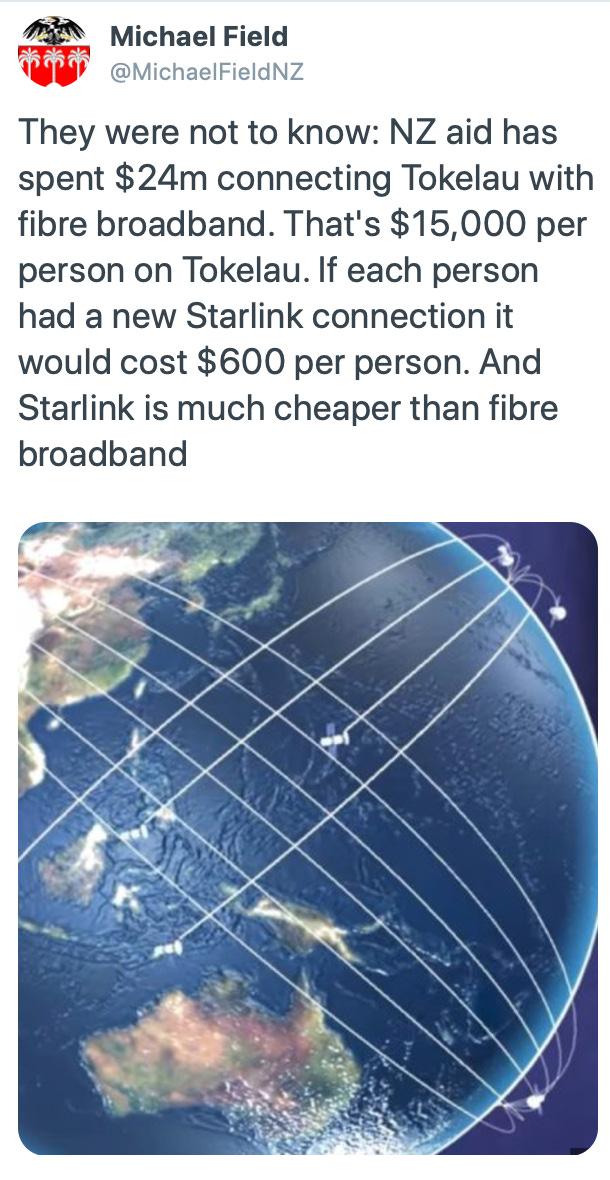Sunday 3 April 2023
A sinking American yacht, Raindancer, won global headlines the other day. Its crew, adrift in the South Pacific, used Starlink, a division of Elon Musk’s SpaceX, to go on the Internet and organise a rescue.
Exciting stuff, but there was more to it and a big question: what will Starlink do to the onshore communications of Pacific nations.
Starlink on its map, is showing their Internet services will be available in Fiji, Samoa, Kiribati, Vanuatu and the Solomon Islands this year.
The Internet has been available at sea and in remote areas using geostationary communications satellites 35,000 kilometres over the Equator. The distance means the signals are extremely laggy, with poor latency and delays. It makes the Internet slow. Starlink’s satellites are 340 km to 1200 km above the surface. This, says Starlink, gives Internet performance comparable to ground-based cable and optical fibre networks that carry most Internet traffic today.
Starlink satellites travel fast. As one satellite moves away from one of its customers, another one must come into view in order to provide a continuous internet connection. Starlink ground stations are flat surfaces, they do not need to be like dishes. Starlink does not even need to be pointed towards a geostationary satellite; it only needs a clear view of the sky. (And ground sets are readily available in retail shops now) Prices vary at the moment; Starlink is competing directly with the much more pricey geostationary market. But its prices are falling markedly and soon will threaten the usually state controlled Pacific telecommunications companies.
Most Pacific nations and territories have been, or are about to, be connected to fibre. Some of it has caused political tensions over the possible involvement of the Chinese Communist Party in their operations. Starlink alone plans to have around 12,000 satellites in orbit; they aspire to have a constellation of cellphone towers in low Earth orbit. Can a state like Samoa or Tonga compete by providing their own Internet connections over the more expensive fibre they’ve ended up with? And what is safer, from an intelligence point-of-view; a Huawei supported fibre cable, or a SpaceX run sky service?
©Michael J Field
In substack postings…
Ta’isi’s writings annoyed Braisby, particularly his account of Aso Pogisa. Ta’isi claimed police had set up three machine guns in a trap where snipers were posted. Braisby denied police had hidden in a lane near the scene of the killings. Braisby spent 20 days on the witness stand.
Kala pani: Thursday 14 May 1897
The coup spread out across all parts of the city and action and roadblocks were a feature for everybody in the city. When gunfire broke out, most people heard it and were often in range of stray rounds. A darker side of Suva grew in the wake of the coup with increased crime, including home invasion and murders. As was demonstrated during the coup, Fiji's sulu-wearing police might look picturesque but their wages are only marginally above the poverty line.
In 1937 Tuimaleali’ifano Si’u called for a celebration of his 100th birthday. There was a family reunion, a church service, a feast and an exchange of mats and money. McKay, the New Zealand civil servant who had been there since deporting Germans, wrote how he was puzzled at the celebration.‘Tui, pardon me for mentioning it, but your last marriage is recorded in the office,’ he said. ‘It shows your age now to be about 83, isn’t it?’ Tuimaleali’ifano replied that he knew that; ‘but if I wait to reach a hundred I may never see it. Much better to have the centenary now, while I’m alive.’
At The Pacific Newsroom …
Former Malaita Premier Daniel Suidani denied US visa
Micronesia’s Congress will convene to select president
Concerns over threats to block Solomon Is water supply
Fiji Sun scoop over Attorney General behaviour
Two Australian denoted patrol boats damaged in cyclones
More flights planned between Tahiti and Rarotonga
Lani Wendt Young writes of her father, the matai
13 Offensive And Annoying Stereotypes About Pacific Islanders




